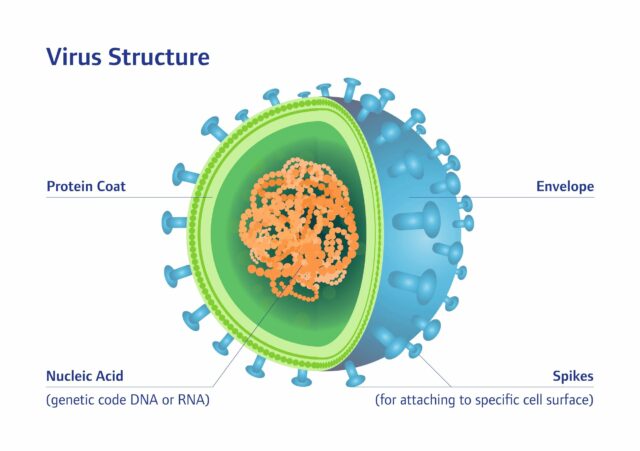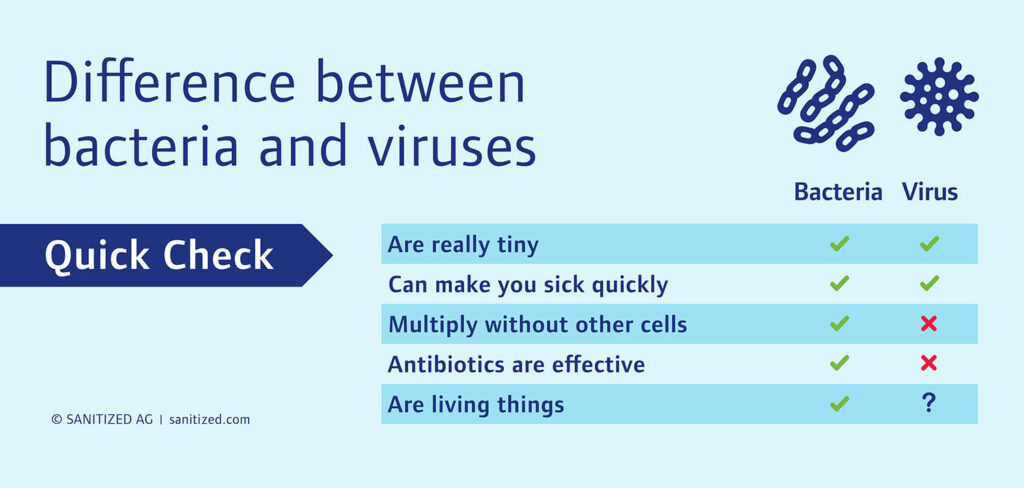In terms of size, viruses fall within the nanometer range, and they are mostly between 20 nm and 300 nm in size and thus ten to a hundred times smaller than the average bacteria cells. However, this by no means indicates that bacteria are exceptionally large – most of them are merely 0.5 to 5 micrometres in size. Now that we have explained the sizes, let’s get to the heart of the matter: How else do bacteria and viruses differ? In this article, we will cover some of the most important differences.
What are bacteria?
Bacteria are organisms that consist of a single cell and are present virtually everywhere in the world. Their structure is relatively simple if we compare them to eucaryotic cells, which include animal and plant cells. They contain a single nucleus and various other organelles that bacteria lack. However, numerous complex processes take place in bacteria cells such as various metabolic pathways and cell division, among other things. This metabolic capability and standalone reproduction makes bacteria living beings.

Let’s begin with the exterior. For starters, bacteria have one cell wall that gives them stability. Pili (plural for pilus) are hair-like cell projections that, along with the capsule, are used to adhere to surfaces but also allow for the transfer of genes. The extracellular, tail-like extension is called a flagellum and is used for locomotion. The delicate cell membrane on the inside of the cell wall separates the interior and controls the transport of substances to the cell’s insides via membrane proteins, and the bacteria’s genetic information is in the DNA. Among other things, it includes blueprints for creating proteins that the bacteria requires for various cell processes. After these DNA sections (genes) are converted into mRNA, they are translated into proteins by ribosomes.
What are viruses?
Unlike bacteria, viruses can reproduce only if they find a suitable host, such as the cell of another living being. Since viruses are generally specific to a host, they only infect certain organisms. To do so, they use injection or endocytosis to inject their genetic material into a foreign cell. At this point, the virus commandeers the cell and forces it to reproduce its genetic material and synthesise envelope proteins and other components of the virus. Afterwards, the newly formed viruses are released and can infect additional host cells.

A virus’ structure is even simpler than that of bacteria. Viruses are mostly comprised of a protein capsule that encloses the genetic information. In addition to the capsid, some viruses, like those in the example above, furthermore have a biomembrane (lipid bilayer) that originates from the original host cell and is riddled with viral membrane proteins. Viruses with this kind of virus envelope are called enveloped viruses, whereas those without an envelope are called “naked” viruses. The virus envelope with spikes is essential for binding the virus to the host cell’s receptors.
Viruses can mutate and adapt to new conditions. We are already familiar with the adaptability of viruses due to the common cold and influenza viruses. This is why you need an annual vaccine for influenza to protect yourself against the most common strains of each flu season. And, of course, we have all witnessed a new virus, SARS-CoV-2, which has shown us how quickly a virus can spread and mutate. Enveloped viruses in particular can change hosts more easily and, e.g., jump from animals to humans. As of 2022, roughly 10,000 virus species are officially recognised. However, it is estimated that mammals alone hold 320,000 unknown types of viruses, and it can be assumed that there is an even greater number of virus types.
Diagnosis and treatment of bacterial and viral infections
If the human body is weakened by a bacterial or viral infection, the immune system fights against the invaders. Viral and bacterial infections are treated differently. For instance, a bacterial infection can be treated with a specific antibiotic that targets the bacterium that causes the infection. A broad spectrum antibiotic can also be used if the bacteria is unknown or if several bacteria need to be targeted.
A viral infection can be a bit more tricky, and most of the time it is up to the host’s immune system to get rid of the invader. Doctors normally recommend drinking lots of fluids, keeping yourself warm, taking painkillers and “letting nature run its course”. Of course, active vaccination is also available to prevent certain virus infections. They help the immune system create antibodies for specific pathogens that help to protect the host in case of an infection. In passive vaccination, for instance, genetically manufactured antibodies are injected to fight the pathogens. Furthermore, there are also some antiviral medicines that fight the herpes virus (fever blisters) and HIV, although it is important to note that these medicines do not cure the virus. They reduce the symptoms and/or the viral load to reduce the risk of transmission and improve overall health. Superinfections occur when a viral infection weakens the immune system and allows for a bacterial infection to take hold.
How can I prevent infections?
Infections can be transmitted by exchanging bodily fluids and aerosols. They are also frequently transmitted via contaminated hands and materials. Bacteria are not only abundant in kitchens and refrigerators, but also in large numbers in airports and gyms. To break the chain of infection, additional hygiene methods apart from cleaning and disinfection can be taken, such as a resistant antimicrobial protection for commonly touched surfaces, among other things. Surfaces and objects made of various materials such as plastics can be directly treated. However, the product can also be integrated into paints or coatings.
Bacterial growth and spreading on these surfaces can be demonstrably reduced via treatment with an antimicrobial function. Thanks to its long lifespan, the integrated Sanitized® hygiene function can be used on surfaces in hospitals or homes for the elderly to improve overall hygiene over the long term. Sanitized® technologies protect surfaces and plastics from microbes.
Overview of the most important differences between bacteria and viruses
To summarize, bacteria are tiny life forms that can make us ill and can independently reproduce. Since viruses do not have a metabolism and cannot reproduce without other cells, they are normally not considered living beings in the literal sense.
SANITIZED AG is a technology partner of the global plastics industry for such topics.
Please contact: csd@sanitized.com







